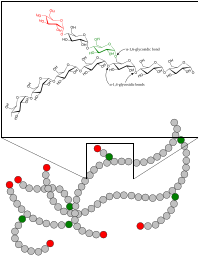Glycogen Storage Disease Due To Glycogen Branching Enzyme Deficiency

Glycogen branching enzyme (GBE) deficiency (Andersen's disease or amylopectinosis), or glycogen storage disease type 4 (GSD4), is a rare and severe form of glycogen storage disease which accounts for approximately 3% of all the glycogen storage diseases (see these terms).
Clinical description
Clinical presentation is extremely heterogeneous and involves the liver or the neuromuscular system. In the classical form, children are normal at birth, but develop hepatomegaly, hypotonia, and developmental delay during their first months. The disease then rapidly progresses to cirrhosis with portal hypertension and ascites, ultimately causing death in early childhood. A non-progressing hepatic form has been reported in a few cases. In the neuromuscular presentation, the age of onset ranges from fetal to adult age. The most severe form starts before birth with decrease or absence of fetal movements, arthrogryposis, hypoplastic lungs, and perinatal death. Patients with congenital forms have severe hypotonia, cardiomyopathy, depressed respiration and neuronal involvement. Milder forms have been reported with later-onset, marked by muscular weakness or cardiomyopathy and heart failure. Neurological adult forms with central and peripheral nervous system dysfunction have also been described, such as Adult Polyglucosan Body Disease (APBD; see this term), which is characterized by widespread upper and lower motor neuron lesions.
Etiology
The disease is caused by mutations in the GBE1 gene (3p12) encoding GBE. GBE deficiency results in storage of abnormal glycogen that resembles an amylopectin-like structure (polyglucosan).
Diagnostic methods
The diagnosis is based on biochemical findings from a liver biopsy, revealing an abnormal glycogen content, and on the evidence of enzymatic deficiency in the liver, muscle, erythrocytes, or fibroblasts, and in the trophoblast or cultured amniotic cells.
Differential diagnosis
Differential diagnoses include galactosemia, hydrops fetalis, and tyrosinemia (see these terms).APBD can also present with or without GBE deficiency indicating that different biochemical defects could result in an identical phenotype.
Antenatal diagnosis
Prenatal diagnosis is possible by enzyme assay and/or DNA analysis.
Genetic counseling
Transmission is autosomal recessive.
Management and treatment
There is no specific treatment. A liver transplant can be proposed in severe forms without associated heart disease.
Prognosis
Prognosis is unfavorable for patients with perinatal onset and classic forms who do not undergo liver transplantation. Long-term prognosis for others depends on the extent, severity, and progression of the condition.